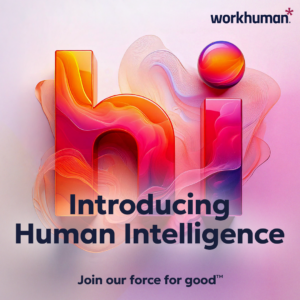
The Upskilling Imperative: Elevating Talent to Thrive in the Modern Workplace
Sponsored by Workhuman. In today’s rapidly evolving workplace, upskilling isn’t just an advantage — it’s a necessity. Employees who learn new skills are more engaged,

Sponsored by Workhuman. In today’s rapidly evolving workplace, upskilling isn’t just an advantage — it’s a necessity. Employees who learn new skills are more engaged,

November being the penultimate month of the year, there’s a lot to reflect on around HR, talent and the workplace. One caveat to get out

For more than two decades, we have lived with this sensibility and reality that we allocate most, if not all, of our corporate attention to

We’re facing turbulent times in the world of work. And not surprisingly, the language we use to describe modern work life is changing just as

Diving into important talent strategy trends for 2024, one theme surfaces again and again. What many call “The Great Work Reset” isn’t over. Far from

There’s nothing like having skin in the game to keep you focused, motivated, and engaged. Just ask any business owner. This logic extends to employees,

Recently, one of the soldiers in my reserve unit decided it was time to hang up the uniform and transition to the civilian world. During

When employees feel disconnected from their jobs — or their work doesn’t bring a sense of purpose to their lives — they’re more likely to

When it comes to implementing a successful engagement strategy, HR teams can’t afford to ignore employee expectations. Yet, research suggests that too many organizations forget

If you lead a business of any kind, it’s essential to understand the factors that influence employee satisfaction in your organization. This kind of insight

The world of work is a little rough these days, to say the least. Companies large and small continue to scramble in the face of

Keeping valued employees onboard is top-of-mind for many organizations these days. But what kind of employee retention strategies are actually working? To find out, we

We may or may not be heading for an economic downturn this year, but we certainly are seeing a slew of layoffs. The technology industry

The pandemic has sparked a global conversation about whether people who’ve been working from home should be free to choose their preferred work location. It’s

When you think about your future within your organization, what do you envision? Do you anticipate moving up through the ranks into a managerial or

As 2022 comes to a close, several work trends are clearly visible on the horizon. Here’s one employers can’t afford to ignore — an alarming

Sponsored by: Worksuite The case for building a flexible talent network has never been more compelling. During the “Great Resignation” of 2021, 47 million U.S.

Employee appreciation is naturally top-of-mind for employers during the holiday season. But employees actually prefer recognition throughout the year. In fact, according to a HubSpot

What benefits are top-of-mind for organizations that want to attract and retain great talent in today’s challenging talent market? Many are finding it pays to

Sponsored by Reejig Countless HR tools, applications, and platforms now rely on artificial intelligence in some form. Users may not even notice that AI is

It’s not a stretch to say COVID changed everything—including the way working families think about childcare benefits. Before the pandemic, parents struggled with childcare challenges,

These days, we’re flooded with headlines about The Great Resignation, The Big Quit, and The Great Reshuffle. It’s not surprising. The desire for career advancement

In response to the Great Resignation, employers everywhere are reevaluating their talent strategies. As part of this process, they’re seeking cost-effective ways to retain employees

If you’re ramping up for Q4 in your workplace, you may be anticipating a slew of quarterly performance reviews. It’s your manager’s last chance of